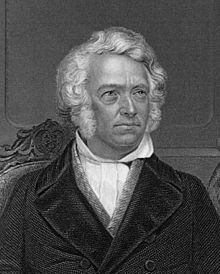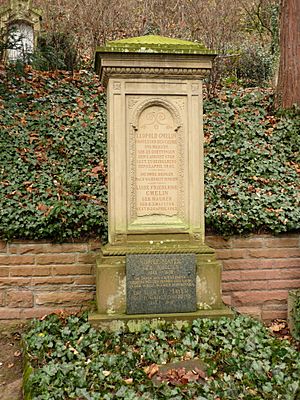Leopold Gmelin facts for kids
Quick facts for kids
Leopold Gmelin
|
|
|---|---|

Leopold Gmelin
|
|
| Born | 2 August 1788 |
| Died | 13 April 1853 (aged 64) |
| Nationality | German |
| Scientific career | |
| Fields | Chemistry |
| Institutions | University of Heidelberg |
| Influences | Friedrich Stromeyer |
Leopold Gmelin (born August 2, 1788 – died April 13, 1853) was an important German chemist. He was a professor at the University of Heidelberg. Gmelin is famous for discovering a chemical called red prussiate. He also created Gmelin's test, which is used to find certain substances. His most well-known work was his Handbook of Chemistry. This book became a very important reference for chemists for many years.
Contents
Early Life and Education
Leopold Gmelin was born in Göttingen, Germany. His father, Johann Friedrich Gmelin, was a doctor, botanist, and chemist. Because of his family, Leopold learned about medicine and science from a young age. In 1804, he started attending his father's chemistry classes.
He later studied at the University of Tübingen. He also worked in his family's pharmacy there. In 1805, Gmelin moved to the University of Göttingen. He worked as an assistant in the lab of Friedrich Stromeyer. He passed his exams successfully in 1809.
Studying in Vienna and Travel
In 1811, Gmelin went to the University of Vienna. There, he focused his research on the "Black pigment of oxen and calves eyes." This work became the topic of his dissertation (a long research paper for a degree). He earned his doctorate degree from Göttingen in 1812, even though he wasn't there.
After that, Gmelin traveled a lot. He went on a long study trip through Italy until 1813. When he returned, he started working at Heidelberg University. He became an associate professor there in 1814.
Learning in Paris
In 1814, Gmelin went on another educational trip to Paris. He stayed there until the spring of 1815. With his cousin, Christian Gottlob Gmelin, he met many famous scientists. These included Joseph Louis Gay-Lussac and Louis Jacques Thénard.
Contributions to Chemistry
In 1817, Leopold Gmelin became a full Professor of Chemistry at Heidelberg University. He worked closely with Friedrich Tiedemann. Together, they published "The digestion after tests" in 1826. This work helped create the field of physiological chemistry, which studies the chemistry of living things.
Discoveries in Digestion and Bile
Gmelin and Tiedemann made important discoveries about digestion. They found hydrochloric acid in stomach juice. They also discovered parts of bile, like cholesterol and taurine. Gmelin later introduced Gmelin's test. This test could find bile parts in the urine of people with jaundice. Their work helped us understand how the body absorbs nutrients.
Red Prussiate and Croconic Acid
In 1822, Gmelin helped Friedrich Wöhler with his work on cyanogen compounds. During this time, Gmelin discovered the Red prussiate. This is a chemical compound with a red color. He also discovered Croconic acid. This was important because it was the first cyclic organic compound he had made.
The Handbook of Chemistry
One of Gmelin's biggest achievements was his Handbook of Chemistry. The first volume came out in 1817. By 1843, the fourth edition had grown to nine volumes. In this edition, Gmelin included atomic theory. He also gave more space to organic chemistry, which was becoming very important.
The Handbook was printed until its 8th edition in 1990. It is now continued as an online database. Gmelin also introduced the chemical terms ester and ketone. He created a system for classifying inorganic substances, which is now called the Gmelin system. This system helped organize chemical information.
Other Work
Leopold Gmelin also worked on improving chemical equipment. He even developed an early version of the Periodic table. His experimental work was known for being very thorough and detailed.
Later Life
When he was 60, Gmelin had his first stroke. He had another one in 1850. These strokes affected the right side of his body. He was able to recover, but he remained weak. In 1851, Gmelin asked to retire, and his request was granted.
For the next two years, his health got worse due to a brain illness. Leopold Gmelin passed away in Heidelberg on April 13, 1853, at nearly 65 years old. He was buried at the Mountain Cemetery in Heidelberg. His wife, Luise Gmelin, and other family members are also buried there.
Images for kids
See also
 In Spanish: Leopold Gmelin para niños
In Spanish: Leopold Gmelin para niños




